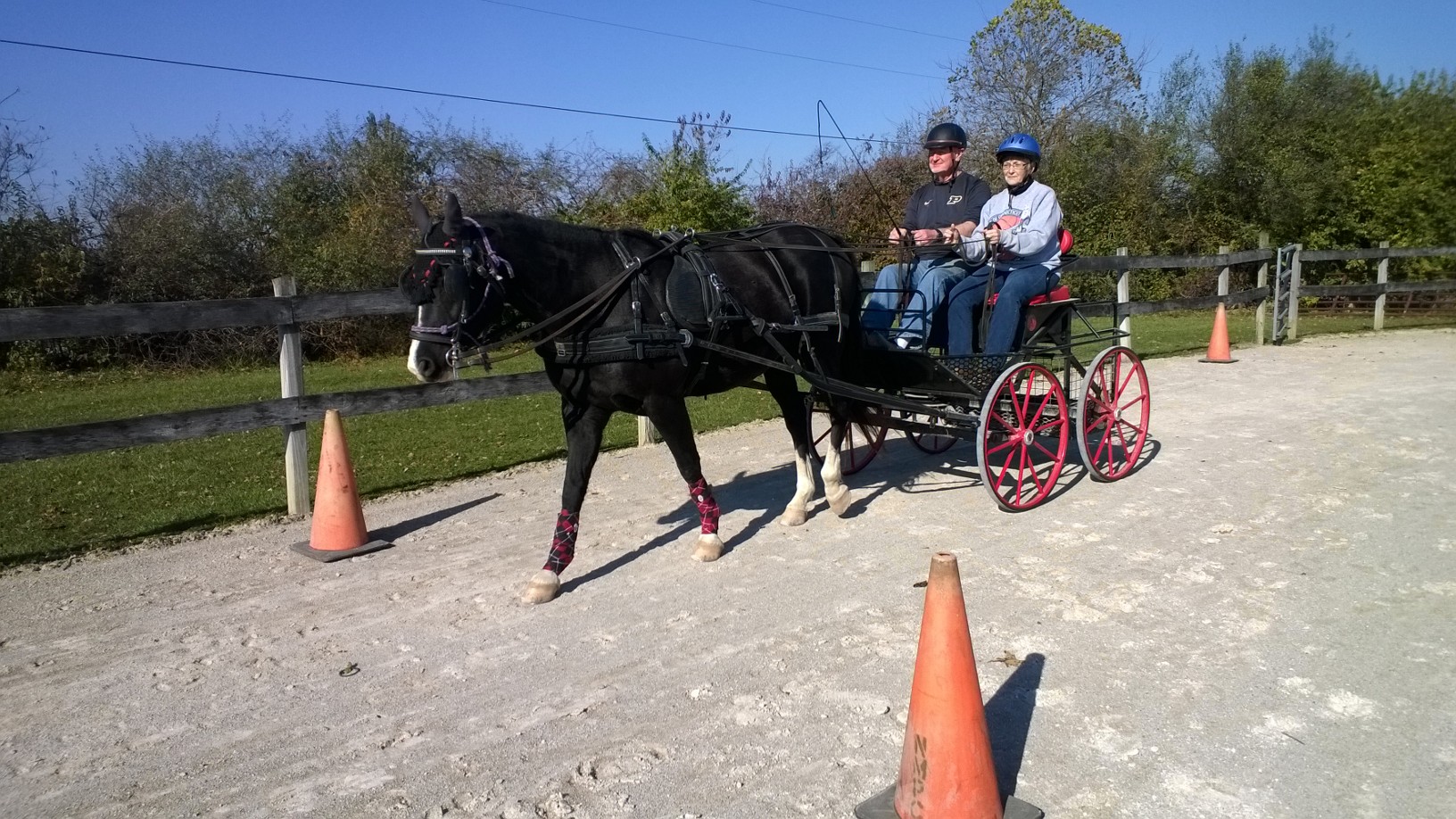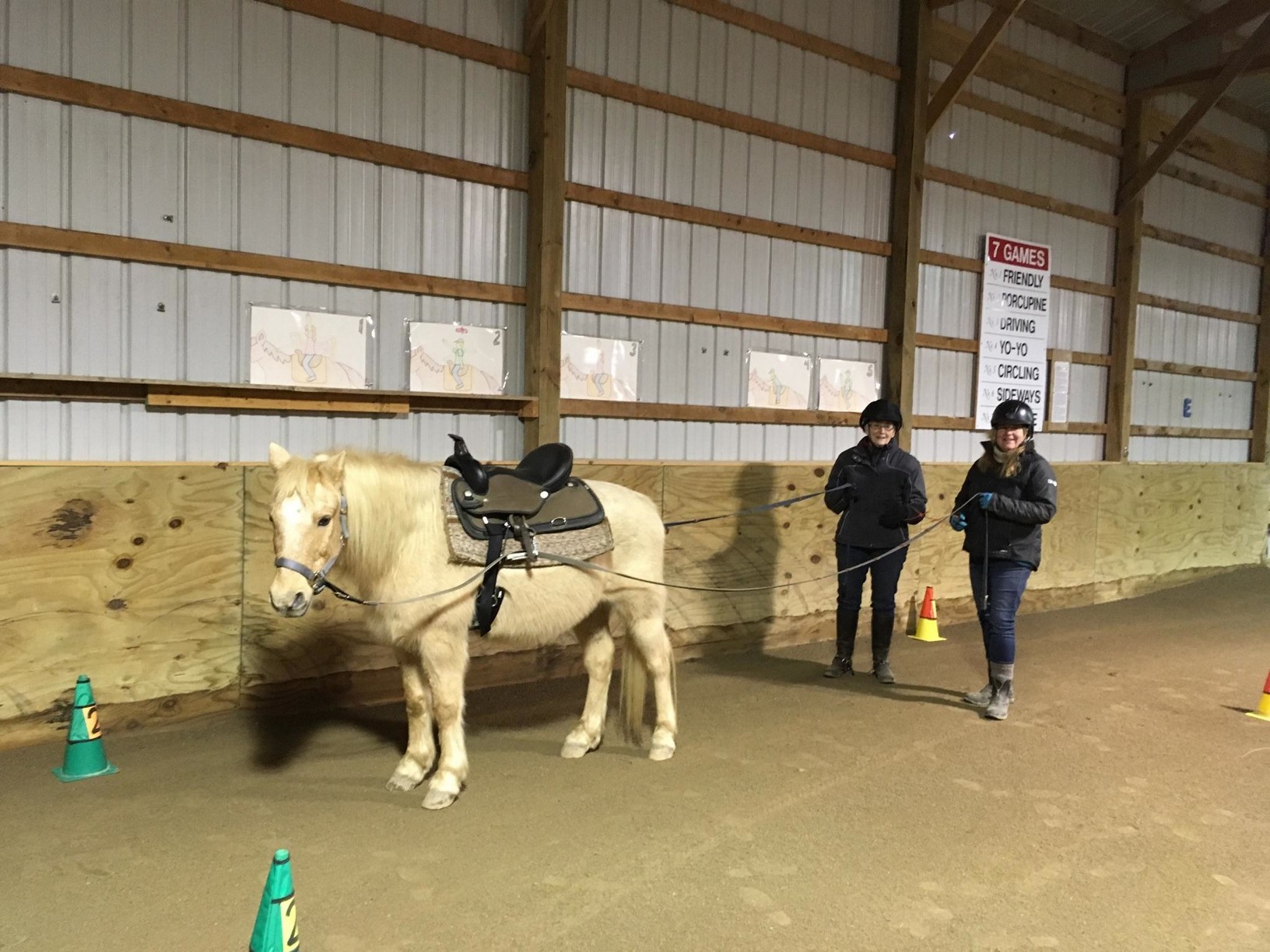
All of the equines at Meadowstone Therapeutic Riding Center in Franklin, Ind., drive a carriage. In fact, the center’s driving animals are actually all ponies, ranging from a miniature horse to a small (14.3 hand) draft horse, and each one performs double duty. Their size is ideally suited to carry children in the center’s new therapeutic riding program, as well as serving in therapeutic driving. Plus, an equine suited for and experienced in driving is as close to “bomb-proof” as can be found for therapeutic riding.
Facing Their Fears
In the last three years, Meadowstone has expanded its children’s and driving program to add equine-facilitated psychotherapy (EFP) for adults and has found its carriage ponies to be excellent therapeutic partners. The center collaborates with Tara Treatment Center, a local in-house program for those recovering from alcohol and drug abuse. One day a week, Meadowstone hosts 10-15 women from the center in the morning and a similar number of men in the afternoon. They are accompanied by a licensed mental health therapist—a PATH Intl. Certified Registered Instructor and Driving Instructor Level 1—to offer equine-facilitated psychotherapy (EFP) to clients. Many people in the groups have never even been close to a horse before coming to Meadowstone.
After an introductory talk about the day’s planned exercise, the participants groom the equines and then take part in one of the activities, some of which involve driving exercises. Afterwards, clients process what they have experienced with the therapist. Meadowstone also allows each participant the opportunity to ride during their last week in the program. Clients are guided around the arena or through a course, and are also allowed to try trotting with a lead.
The center uses a mix of rotating exercises from Equine Assisted Growth and Learning Association (EAGALA) programs and from the author’s PATH Intl. experience. The exercises range from learning to catch and halter a horse, clean a horse’s hooves, and saddle a horse, to more complicated lessons such as free longeing a horse in a round pen and taking an unhaltered horse through an obstacles course as a team or individually. The discussions with the therapist after these exercises often focus on major themes in the life of a person who is in recovery: learning to trust other people and work as a team; asking for and accepting help; problem-solving; and taking directions and experiencing success with an activity that can seem daunting. Clients are challenged with unaccustomed and/or fear-provoking tasks to help break through their barriers. Some of them desperately need to learn to believe in themselves and find confidence. Others need almost exactly the opposite: to stop trying to rely solely on themselves and learn to work with others, their higher power, and the recovery program.
Teamwork Challenge
Two new exercises that came directly from the author’s driving background have met with great success with this group. The first is long-lining a horse through a simple figure 8 cones course. What makes this assignment more difficult is that teams of two are used, with one person holding the left rein and the other holding the right rein. It becomes imperative that clients learn to work together and communicate if they don’t want to end up going in circles. The center’s driving ponies are uniquely suited to this exercise since they are so practiced in responding to long-lines while hitched.
However, the best-received exercise is called “Hitch ’em Up.” Two equines are standing in the outdoor hitching area with volunteer able-bodied whips at their heads. One is fully hitched to a four-wheel, two-seat carriage. The other has a dissembled set of matching harness and a similar carriage. The clients are lined up and each given a piece of tack, assigned in the proper order of hitching. No one but them can touch their harness piece, and the pieces must be put on in order. However, the whole team is assigned to look at the model horse and figure out how to put it all together. Besides getting advice from teammates, they are also allowed to ask for help from the instructor and other staff. (Clients do not bridle the horse.) This always makes for a very interesting and challenging 20 minutes but with help and a few suggestions, they always manage to get the second horse hitched. (An instructor always inspects the turnout thoroughly before driving.)
Once both horses are properly hitched and bridled, those clients who wish can learn to drive. Experienced drivers with a second set of reins sit up on the box beside the novice drivers, who learn to walk, trot, whoa and change direction in the arena. Pairs of wide-set cones are around the outside of the arena to ensure that the carriage wheels stay far enough away from the fence posts to avoid collision—a common mistake of new drivers. At the end of the drive, clients are challenged to change direction at the trot through three sets of cones without hitting any of them.
There is always major excitement during and after this lesson. Most of the clients who will have driven for the very first time have absolutely loved it. Even those who have ridden before find it a totally new experience. One young woman from the inner city exited the carriage crying. She had been successful in her final test, and her fellow teammates had applauded her. She said it was the first time in her life she had truly felt successful. (Four weeks earlier, she had come into the program afraid to even touch a horse.)
Driving and Recovery Parallels
In processing this lesson with the therapist, clients discuss their experiences learning to work as a team, to ask for and accept help from others. They often struggle to figure out where and how to put their piece of the harness on the horse until they receive input from their teammates. It also shows them that a task that may seem as overwhelming and impossible as hitching a horse (like recovery is to someone who has struggled for a long time) can actually be very doable when the person breaks it down into orderly pieces (the 12 steps) and asks for and receives help from others (attending meetings with others in recovery). There is also tremendous symbolism in having the experienced whip sitting next to the novice driver (just like a sponsor supports the person in recovery). The extra driver will step in and guide the horse if necessary to avoid disaster. Mostly they offer advice and support.
Meadowstone’s driving ponies have proven themselves valuable in a therapeutic horsemanship program of almost any type. Their smaller size and calm temperament make them ideal for children to ride. Yet, they can still work in a therapeutic driving program for adults and partner with therapists and PATH Intl. Certified Professionals in EFP sessions.

Julia Oliver and her husband, Bob, founded Meadowstone Therapeutic Riding in 2008. She is a PATH Intl. Certified Registered Instructor and Driving Instructor Level 1 and the author of Theme-Driven Therapeutic Riding Curriculum and Carriage Games and Activities.
Shared with permission from the Spring 2017 issue of PATH Intl. Strides.


